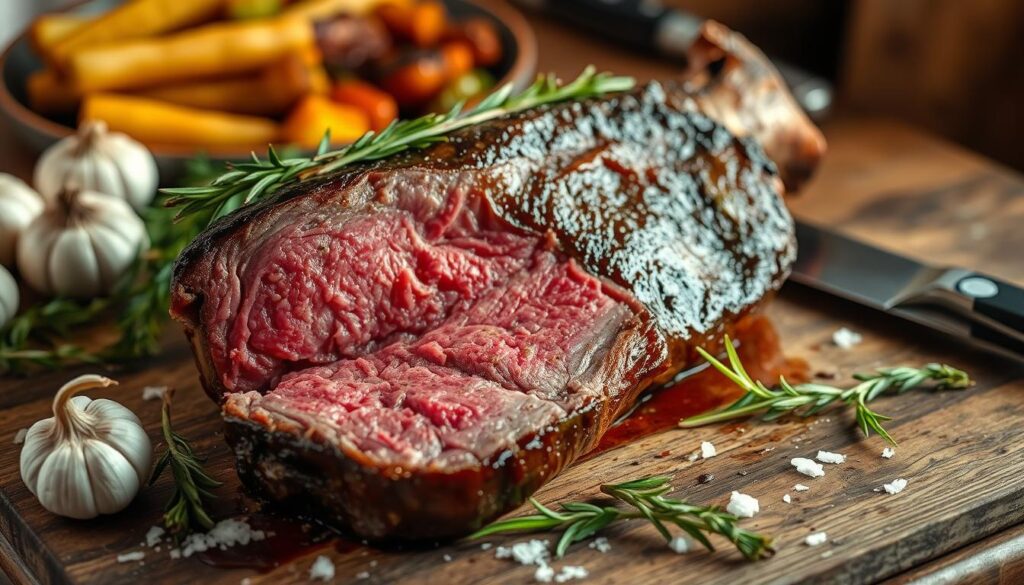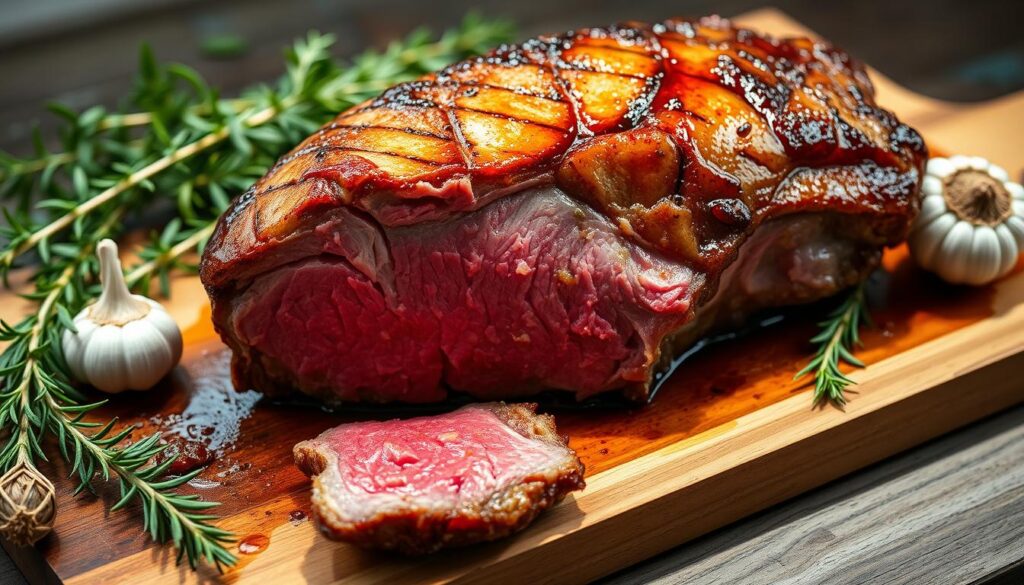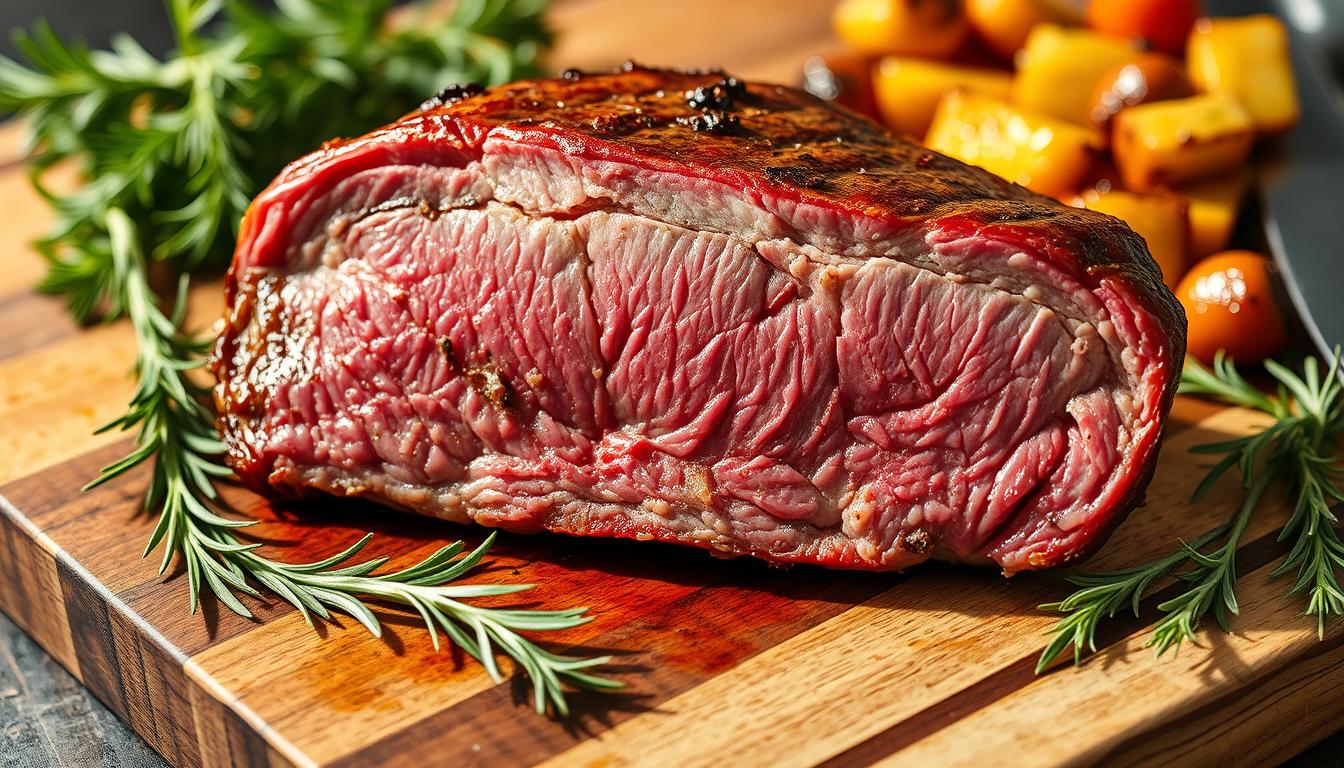Cooking a ribeye roast is more than just making a meal. It’s about creating memories, celebrating together, and filling the air with the smell of seared beef. My first ribeye roast was on a crisp Sunday afternoon. The golden sunlight filled the kitchen, and the promise of a delicious dinner was in the air.
As the roast cooked, the excitement grew. It echoed through our home. This recipe is my way of sharing that moment with you. You can make the best ribeye roast, bringing joy and laughter to your gatherings. We’ll explore the key techniques, from choosing the right cut to cooking it perfectly.
Let’s start this flavorful journey together. It will become a cherished memory for you1.
Key Takeaways
- Ribeye roasts are known for their flavorful and tender meat, ideal for family gatherings.
- The cooking process involves key steps such as selecting quality meat and precise cooking times.
- Understanding temperatures is key; for medium-rare, aim for 135°F.
- Resting the roast after cooking helps distribute juices, improving flavor.
- This ribeye roast can serve many, making it perfect for events.
- Ideal cooking time is about 20 minutes per pound after browning.
Introduction to Ribeye Roast
Ribeye roast is a top pick for those who love flavorful and tender beef. It’s known for its rich marbling and easy cooking. This cut comes from the cow’s rib section and weighs 3-5 pounds, perfect for big meals2.
Unlike prime rib, ribeye roast is boneless, making it easy to carve. I love how it turns out with little effort. It’s a real crowd-pleaser.
What is Ribeye Roast?
The ribeye roast is famous for its tenderness and rich taste. This comes from the fat inside the meat, called marbling. When cooked, this fat melts, keeping the meat juicy and tasty.
For the best taste, cook it to a medium-rare of 135°F (57°C)2. Season it well with kosher salt and let it rest after cooking. This brings out its natural flavors.
Why I Love Cooking Ribeye
Cooking ribeye is a joy. It always results in a tender roast that wows everyone. The prep is simple, letting me relax and enjoy the cooking process.
Season it with kosher salt and garlic for amazing flavor2. The crust that forms adds a wonderful texture. A good ribeye roast brings people together, making meals special.
Choosing the Right Ribeye
When picking a ribeye roast, knowing the different cuts is key. The meat’s texture and taste can change a lot. You’ll often find bone-in and boneless roasts. Bone-in ones taste richer, while boneless ones are easier to carve.
Different Cuts of Ribeye
Bone-in and boneless ribeye roasts have big differences. Here’s a quick guide:
| Attribute | Bone-in Ribeye | Boneless Ribeye |
|---|---|---|
| Flavor | Rich, more intense | Milder, easily customizable |
| Carving Difficulty | Challenging due to bones | Easier, clean slices |
| Typical Weight | 5 to 10 lbs | 5 to 6 lbs |
Selecting Freshness and Quality
I always check for a bright red color and firm texture when picking a ribeye. Meat with lots of marbling is tastier and tenderer. I look for USDA Prime grade for the best flavor.
For roasts under 5 pounds, they usually serve 5 people. Dry-brining for 12 to 48 hours boosts the taste. Freshness is key for a juicy meal. I also check for quality by choosing well-known brands at my local market34.
Essential Ingredients for Ribeye Roast
To make a tasty ribeye roast, you need to know the key ingredients. Seasoning and using good kitchen tools are key. The right mix can make the meat’s natural flavors pop, making your meal unforgettable.
Understanding the Role of Seasonings
For a flavorful ribeye roast, use kosher salt, black pepper, garlic powder, and fresh herbs like rosemary and thyme. These seasonings boost the meat’s taste. I often add 2-3 crushed garlic cloves for a deeper flavor.
Also, 3 tablespoons of salt and 2 tablespoons of black pepper make a great crust. You can adjust these amounts to your liking. Adding 4 tablespoons each of butter or olive oil makes the meat moist and rich5. Finding the right balance of these ingredients is key to a savory ribeye roast.
Must-Have Kitchen Tools
For a ribeye roast, you’ll need a few essential tools. A strong roasting pan and a meat thermometer are must-haves. The thermometer helps you reach a perfect internal temperature of 130-135°F for medium-rare6.
Start by searing the roast at 450°F for 20 minutes to get a nice crust. Then, finish it at 325°F. Don’t forget to use butcher’s twine to tie the roast for even cooking. These tools ensure your ribeye roast turns out delicious and impressive.
Preparation Steps for Ribeye Roast
Preparing a ribeye roast needs careful steps, starting with trimming and seasoning. I trim off excess fat for a cleaner look and better taste. Then, I season the meat with kosher salt, black pepper, garlic powder, and herbs for a tasty dish.
Make sure to spread the seasonings evenly to bring out the ribeye’s natural flavors. Tying the roast with butcher’s twine helps it cook evenly and keeps its shape. The whole process takes about 2 hours, giving the flavors time to meld together before serving7.
Trimming and Seasoning the Meat
For a great how to cook ribeye roast, start with trimming and seasoning. This step boosts the taste and looks of the dish. A medium-rare ribeye should be removed from the oven at 125ºF for a perfect pink center8.
Also, let the roast sit at room temperature for 1 to 2 hours before cooking. This ensures it cooks evenly.
Creating a Marinade (Optional)
Marinating is not needed because ribeye is naturally tender. But, it can add extra flavor. Mix Worcestershire sauce, garlic, and herbs for a marinade. Rub it all over the roast and let it sit for 30 minutes before cooking.
This step not only adds flavor but also makes the meat more tender. Spending time on these preparation steps really improves the taste and texture9.

Cooking Methods for Ribeye Roast
There are two main ways to cook ribeye roast: oven roasting and sous vide. Each method has its own benefits and can make a juicy ribeye roast. Knowing these methods can make your cooking better and your results delicious.
Roasting in the Oven
Oven roasting is a classic way to cook ribeye roast. Start by heating your oven to 450 degrees Fahrenheit for about 15 minutes. This high heat creates a tasty crust on the outside. Then, lower the temperature to 325 degrees Fahrenheit.
Let the roast cook for about 20 minutes per pound. Make sure it reaches an internal temperature of 110-115 degrees Fahrenheit for medium-rare. After cooking, let it rest for at least 30 minutes. This step makes the roast even more tender and juicy.
Sous Vide Technique
The sous vide method gives you exact temperature control. This means you can’t overcook your ribeye roast. By sealing the meat and cooking it in water, the roast cooks evenly.
This method keeps all the meat’s natural flavors. Cooking time varies from 1 to 4 hours, depending on your preference. It ensures your roast stays tender and flavorful.
Perfect Temperature for Cooking Ribeye
Getting a perfect ribeye roast is all about quality meat and the right temperature. Knowing the best cooking temperatures is key. Tools like a meat thermometer help you cook your ribeye to perfection.
Using a Meat Thermometer
A digital meat thermometer is a must-have. It gives you precise internal temperature readings. For a great ribeye roast, start by browning at 450°F for 15 minutes. Then, roast at 325°F for even cooking10.
When checking your meat, aim for medium-rare (125°F to 130°F after resting) to medium (135°F to 145°F after resting)11. This ensures your ribeye is both flavorful and tender.
Understanding Doneness Levels
Knowing the internal temperatures for different doneness levels is key. Here’s a quick guide:
| Doneness Level | Internal Temperature | Final Temperature After Resting |
|---|---|---|
| Rare | 115°F | 120°F to 130°F |
| Medium Rare | 120°F | 130°F to 135°F |
| Medium | 125°F to 130°F | 135°F to 140°F |
| Medium Well | 130°F to 135°F | 145°F to 155°F |
| Well Done | 140°F to 150°F | 155°F to 165°F |
Let the ribeye roast rest for 10 to 20 minutes after cooking. This allows the temperature to rise by 5 to 10 degrees10. By following these tips, your ribeye will surely impress!

Baking Time: How Long to Cook Ribeye
Knowing how long to bake a ribeye roast is key to getting it just right. The time needed changes based on the roast’s size and the cooking method. For example, a 4.5-pound roast might take 1 hour and 20 minutes to 1 hour and 45 minutes to cook. Making sure the meat is at room temperature before baking can make a big difference in tenderness.
Factors Affecting Cooking Time
Several things affect how long it takes to cook a ribeye roast. Here are the main factors:
- Size of the roast: Bigger roasts need more time; a bone-in ribeye roast takes about 18 to 20 minutes per pound at 325°F after an initial high-temperature cooking phase.
- Initial temperature: Letting the roast warm up to room temperature before cooking can cut down on baking time. Cold meat takes longer to cook.
- Cooking method: Different cooking methods, like sous vide or conventional oven, change the time needed to reach the right doneness.
Adjusting for Different Sizes
When adjusting your ribeye roast recipe for size, follow these guidelines:
| Type of Roast | Minimum Weight | Recommended Time (per pound) | Resting Time |
|---|---|---|---|
| Bone-in Ribeye | 4 pounds | 18-20 minutes | 20 minutes |
| Boneless Ribeye | 4 pounds | 13-15 minutes | 20 minutes |
A 4-bone ribeye roast can serve about 8 people. A smaller 3-pound roast might take around 1 hour and 15 minutes to cook. It’s important to check the internal temperature closely, aiming for 110°F to 115°F for rare or medium-rare doneness. Remember, during the resting period, the internal temperature can rise by 5 to 10°F as well1213
In summary, the secret to a great ribeye roast is understanding the baking time for your specific piece of meat. Adjust for size, method, and desired doneness for the best results. This way, you’ll enjoy a juicy and flavorful meal14.
Making the Perfect Gravy
Creating a rich gravy is key to making a delicious ribeye roast even better. It adds depth to the meal, making it more enjoyable. Using the pan drippings, you can make a sauce that captures the roast’s essence.
Ingredients for Delicious Gravy
To make a robust gravy, you’ll need:
- 1/3 cup of beef pan drippings
- 1/3 cup of all-purpose flour
- 3 cups of low sodium beef broth or water
- Fresh herbs like rosemary and thyme for flavor
Many chefs suggest using low sodium beef stock. This helps avoid over-seasoning, as the roast can be quite salty15.
Simple Gravy Preparation Steps
Preparing the gravy is easy. Here’s how I do it:
- After removing the roast, let the drippings settle.
- Skim off excess fat, leaving about 1/3 cup of drippings.
- Add flour to the drippings and cook for 2-3 minutes, until golden.
- Slowly whisk in the beef broth, making sure there are no lumps.
- Simmer for 3-4 minutes until it thickens.
- Season with salt, pepper, and herbs to taste.
Following these steps will give you a flavorful gravy. It complements your ribeye roast and adds savory notes to the meal. Serving it over the meat or with your favorite sides makes the meal complete. It’s a great addition to any gathering, making it special, like during Christmas and Thanksgiving15.
Serving Suggestions for Ribeye Roast
When I think about serving ribeye roast, it’s clear it’s more than just the meat. The right sides can make the meal special. I enjoy pairing my ribeye roast with different sides to match its rich taste.
Ideal Side Dishes
For a complete dinner, try these side dishes:
- Mashed Potatoes: They’re creamy and buttery, a perfect contrast to the savory beef.
- Sautéed Spinach: A light and healthy choice that brings a fresh taste.
- Roasted Asparagus: It adds a nice crunch and earthy flavor to the meal.
- Grilled Vegetables: Seasonal veggies make the plate colorful and textured.
Wine Pairings that Complement Ribeye
Choosing the right wine can really make your meal better. I prefer a full-bodied red wine to match the ribeye’s strong flavors. Here are my favorites:
| Wine | Tasting Notes |
|---|---|
| Cabernet Sauvignon | Rich, full-bodied with dark fruit flavors and a hint of spice. |
| Merlot | Soft, with a plush texture and notes of cherry and plum. |
| Malbec | Bold with deep flavors of blackberry and cocoa. |
With the right preparations and pairings, serving ribeye roast is a special event. These choices not only improve the meal but also make the atmosphere warm and inviting16.
Storing Leftovers of Ribeye Roast
Storing ribeye roast right can make leftovers last longer and taste better. Wrap the prime rib well to keep it fresh in the fridge for five to seven days17. You can freeze it for up to six months17. I like using a vacuum sealer to keep moisture and flavor in, but they can be expensive18.
Best Practices for Refrigeration
For a tasty leftover ribeye roast, store slices in heavy-duty freezer bags. Place them on the bottom shelf of the fridge to avoid juices mixing with other foods18. I use freezer paper to wrap leftovers, keeping moisture in for later18.
Creative Ways to Use Leftover Roast
Leftover ribeye roast is very versatile. I love it cold in a sandwich or reheated with broth to stay moist17. It’s also great in soups, like Leftover Prime Rib & Barley Soup, for a warm meal17. Try it in stir-fries or on baked potatoes for a tasty reuse.
Conclusion
Cooking a ribeye roast is a fun and rewarding task. I’ve shared my best tips to make a perfect ribeye roast every time. From picking the right cut to cooking and resting it, each step is important for delicious results.
Adding the right sides and wine makes the meal even better. It’s a special experience to enjoy.
Recap of My Ribeye Roast Experience
Preparing this easy ribeye roast recipe taught me a lot. Letting the roast rest for 10-15 minutes after cooking is key. It keeps the meat juicy and flavorful19.
Using high-quality meat, about four pounds, makes a big difference in taste20. This roast is perfect for gatherings, showing off your cooking skills and love for good food.
Encouragement to Try This Recipe
I highly recommend trying this ribeye roast recipe. It’s more than just a meal; it’s an experience for your taste buds and senses. Whether you’re new to cooking or experienced, this recipe can be tailored to impress your guests.
For detailed guidance on making the perfect ribeye roast, check out this resource. It will help you achieve the best results.
FAQ
What is the best way to cook a ribeye roast?
How do I ensure my ribeye roast is juicy and tender?
What sides pair well with ribeye roast?
Can I use a marinade on ribeye roast?
How long should I cook a ribeye roast?
What is the difference between bone-in and boneless ribeye roast?
How should I store leftover ribeye roast?
What cooking tools do I need for preparing a ribeye roast?
Source Links
- Easy Ribeye Roast – Healthy Recipes Blog
- Ribeye Roast Recipe: A Classic for Any Occasion
- Perfect Rib Eye Roast
- Perfect Prime Rib Guide
- The Best Ribeye Roast Recipe
- Easy Garlic & Herb Ribeye Roast Recipe (video)
- Beef Ribeye Roast (Prime Rib)
- Ribeye Roast | Get Inspired Everyday!
- How to Make a Ribeye Roast
- How to Cook a Boneless Rib Eye Roast
- Rib Eye Roast | Imamother
- Bone In Standing Ribeye Roast Recipe
- Easy Ribeye Roast (Prime Rib)
- Air Fryer Herb Prime Ribeye Roast
- The BEST Prime Rib Gravy Recipe!
- Boneless Ribeye Roast Recipe
- What to Do with Leftover Prime Rib
- Saving Leftover Steak: What You Need to Know
- How To Cook Ribeye Roast in the Oven | Steak University
- Roasted and Reverse Seared Prime Rib Recipe

